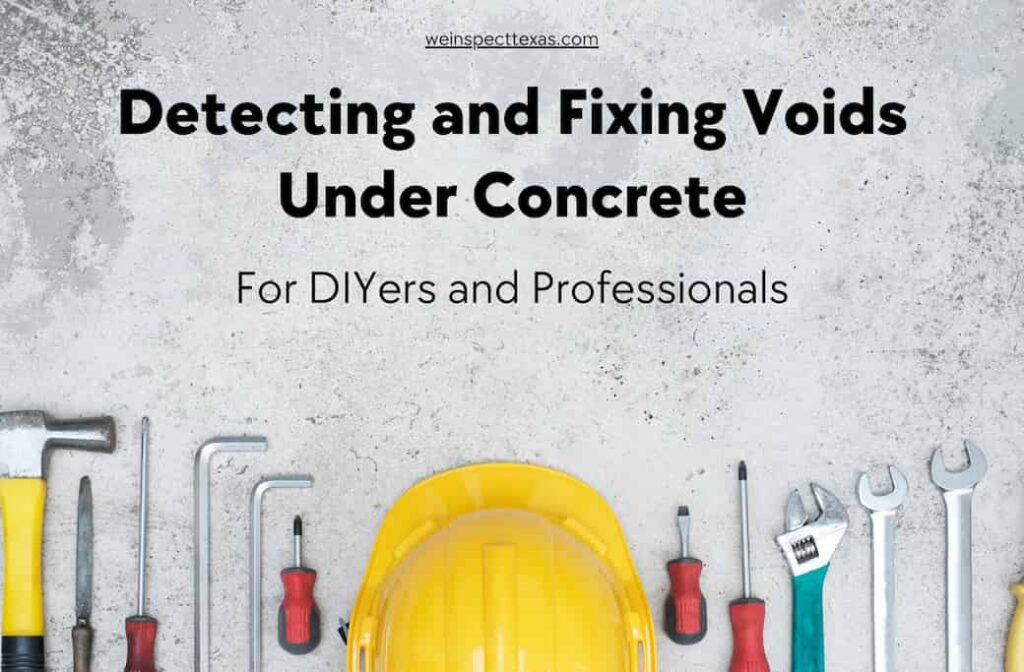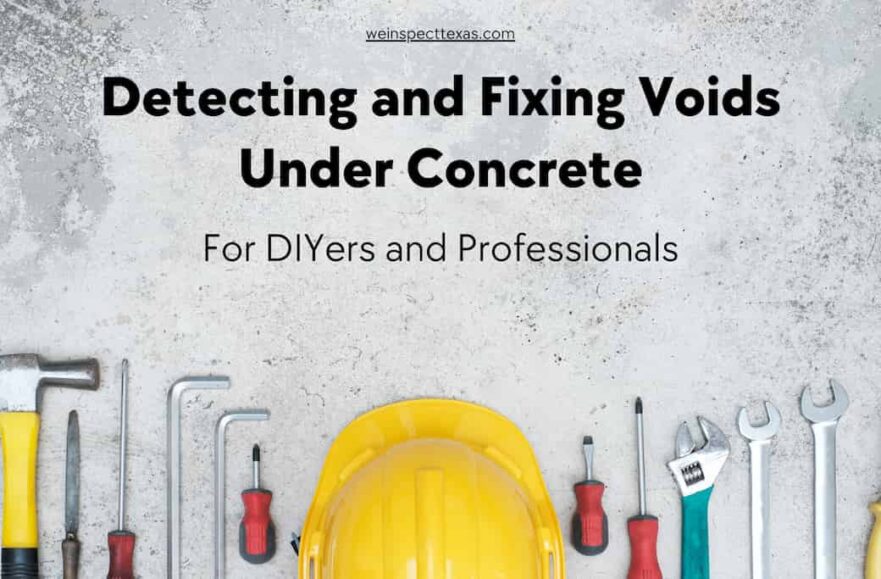
Concrete is widely used in construction due to its durability and strength. However, one common issue that can arise over time is the formation of voids beneath concrete slabs. These voids, also known as sub-surface voids or sinkholes, can undermine the structural integrity of the concrete and lead to problems such as cracking, settling, and uneven surfaces. A void that’s large enough could even lead to concrete collapse.
Understanding how to detect voids under concrete, as well as how to get them fixed, is crucial to maintain the stability and longevity of the structure, as well as the safety of anyone who uses it. There are some DIY methods of detecting voids, along with professional detection methods such as ground penetrating radar. Both methods can be valuable, although professionals typically have more detection equipment that can be used to get answers faster.
Any DIYer who believes they’ve found a void will want to follow up with a professional inspection and then work with the company to address the void for safety. Even a small void should be taken seriously, as it could continue to get worse over time. Here’s what DIYers and professionals typically do when detecting and fixing voids under concrete.
How to Detect Voids for DIYers
One of the best ways to detect voids is with ground-penetrating radar that can spot issues that can’t be seen with the naked eye. For a DIYer, though, discovering whether the space is hollow under a concrete slab has to be handled a little differently. DIYers don’t have the same kind of equipment that professional companies use, so they have to resort to other methods.
Visual Inspection
One of the best ways for a DIYer to discover potential voids under concrete slabs is through a thorough visual inspection. That means looking for any signs of void damage, such as sinking, cracks, or uneven surfaces. If the concrete looks like it’s sinking in the middle, for example, or if there are a lot of cracks getting started in a corner, there may be a void in that area. Concrete should be smooth and level, and any changes to it should be investigated.
If you’re a DIYer it’s also very important for you to know what you’re looking for as you give your concrete a careful examination. Irregularities in the concrete can develop slowly, or they can show up virtually overnight. If a void develops suddenly, the stress of the concrete’s weight could cause cracking and shifting in a short period of time. If you notice changes, talking to a professional is important. That’s true of rapid changes, and also cracks and other problems that appear over time.
Acoustic Testing
You can also use the power of sound to locate voids under concrete slabs. The acoustic testing method involves tapping on the concrete surface in various spots, listening for a change in sound transmission. If one area sounds hollow, or doesn’t sound the same as other areas, it’s important to find out why.
Understanding how to detect voids under concrete isn’t something a lot of homeowners think about, but it can be extremely valuable to learn how a concrete slab should sound, so you can take note of any changes to that sound. Changes in the sound of the concrete at your home or business should be monitored and inspected, in case a void has developed underneath.
How to Detect Voids for Professionals with Equipment
Professionals who detect voids under concrete slabs have special equipment and methods they use to do that. There are several ways to find these voids, and it’s important to make sure that the right equipment is being used for the specific situation.
Ground Penetrating Radar (GPR)
Ground penetrating radar, or GPR, is among the best methods to detect voids under concrete. This is a non-destructive testing method that uses electromagnetic radiation to create an image of the subsurface. It can accurately locate voids and provide information about their size and depth. When using GPR to look for hollows and voids, this method of concrete structure scanning means professionals can quickly see if there’s space under a concrete slab.
Infrared Thermography
Infrared cameras can detect variations in surface temperatures, which can be indicative of voids beneath the concrete. By examining the temperature patterns, professionals can identify potential void locations. This is another convenient way to find a void, typically before it starts causing damage.
Ultrasonic and Echo Testing
Much like infrared and GPR, ultrasonic and echo testing are ways to map out voids under concrete without damaging the slab. Using sound waves, they can provide a clear picture of the surface located under the slab, to help professionals determine whether a void or hollow is present.
Concrete Core Sampling
This method of finding voids isn’t as common, because it’s more invasive than other options. It involves drilling small cores from the concrete slab. The extracted samples can then be inspected for voids and void-related issues such as soil erosion or water infiltration.
Benefits of Partnering with Professionals for Void Detection
While it’s certainly possible for a DIYer to find a void through visual and acoustic testing, partnering with professionals is the best way to locate a hollow under a concrete slab. The use of ground penetrating radar means you can get the information you need from professionals you trust, and that can help you decide on the next steps before a potential problem with a void becomes any worse.
Accuracy
Cost Efficiency
No Excavation Needed
Reliability
Quick and Convenient
How to Fix Voids Under Concrete Slabs
How to fix a void under a concrete slab will depend on the severity and size of the void, along with whether you’re planning to do it yourself or hire a professional. In some cases, especially for smaller issues, you may be able to use a DIY solution. Larger voids, or voids that can’t easily be accessed, may need the help and support of a professional.
Concrete Patching (DIY)
For small voids you can access, such as at corners or along an edge, concrete patching can be a good way to fix the void without a lot of stress. You want to make sure you prepare the surface according to the directions on the patching material, so it sticks to the existing concrete properly. Filling a void is about structural integrity, and that’s much stronger when the new material bonds to the old.
After the surface is prepared, mix up the patching material and apply it to the void. Take your time, but also be mindful that the concrete patching material will start to cure. You don’t want to spend too long working with it, and being efficient can help you get it done right without rushing, but while making sure the material is in place before any significant drying begins.
Slab Jacking (DIY)
Slab jacking, also known as mud jacking, is a technique used to lift and level settled concrete slabs. In this process, you would use a slurry mixture that’s usually a combination of cement, soil, and water, and inject it through small holes you’ve drilled into the slab. As the slurry fills the voids, it raises the concrete slab to its original position.
This might sound like a daunting task, but it really doesn’t have to be. There are slab jacking kits to help you get everything done right and walk you through the proper steps. It’s important to monitor the process of filling the void, because the mixture you’re adding will start to raise the concrete slab. You want to level the slab while also filling up the void.
Pressure Grouting and Polyurethane Foam Injection (Professionals)
Pressure grouting isn’t something that a DIYer can do. It involves injecting a cement-like or polyurethane grout into the void under pressure. This process fills the voids, compacting the soil while also stabilizing the concrete slab. Professional expertise is required to ensure proper grout placement and prevent over-pressurization.
This is a very common method that professionals use for void repair, where pressure grouting is typically used for larger voids and polyurethane foam is used for smaller voids. The grout or foam expands and fills up the void, making the area stronger and more stable in the process.
Detecting and fixing voids under concrete is crucial for maintaining the structural integrity and stability of concrete slabs. DIYers and professionals can use several methods to identify and rectify voids, depending on the severity of the issue and the available resources.
While some minor voids can be addressed using DIY techniques such as slab jacking, larger or more complex voids may require professional intervention and more extensive repair methods. By addressing voids promptly and effectively, you can prevent further damage and ensure the long-term stability of concrete structures.

